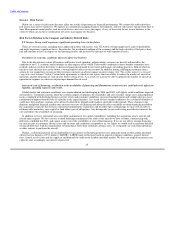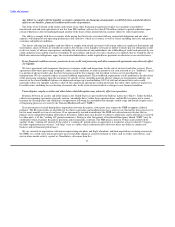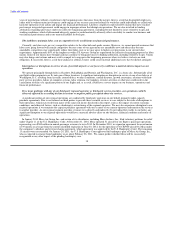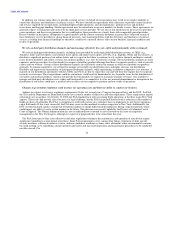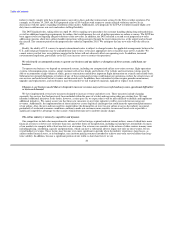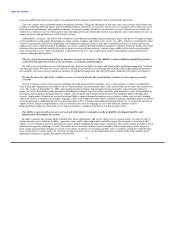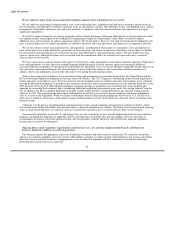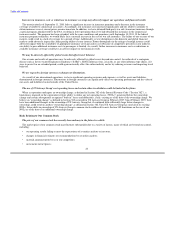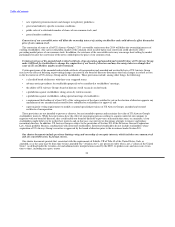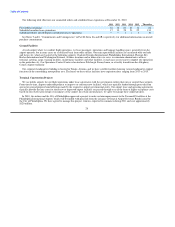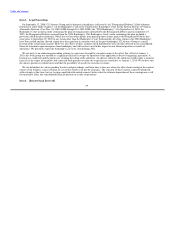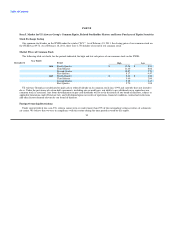US Airways 2010 Annual Report Download - page 22
Download and view the complete annual report
Please find page 22 of the 2010 US Airways annual report below. You can navigate through the pages in the report by either clicking on the pages listed below, or by using the keyword search tool below to find specific information within the annual report.
Table of Contents
more susceptible than other major airlines to competition from surface transportation such as automobiles and trains.
Low cost carriers have a profound impact on industry revenues. Using the advantage of low unit costs, these carriers offer lower fares
in order to shift demand from larger, more-established airlines. Some low cost carriers, which have cost structures lower than ours, have
better financial performance and significant numbers of aircraft on order for delivery in the next few years. These low-cost carriers are
expected to continue to increase their market share through growth and, potentially, further consolidation, and could continue to have an
impact on the overall performance of US Airways Group.
Additionally, as mergers and other forms of industry consolidation, including antitrust immunity grants take place, we might or might
not be included as a participant. Depending on which carriers combine and which assets, if any, are sold or otherwise transferred to other
carriers in connection with such combinations, our competitive position relative to the post-combination carriers or other carriers that
acquire such assets could be harmed. In addition, as carriers combine through traditional mergers or antitrust immunity grants, their route
networks will grow and that growth will result in greater overlap with our network, which in turn could result in lower overall market
share and revenues for us. Such consolidation is not limited to the U.S., but could include further consolidation among international
carriers in Europe and elsewhere.
The loss of key personnel upon whom we depend to operate our business or the inability to attract additional qualified personnel
could adversely affect the results of our operations or our financial performance.
We believe that our future success will depend in large part on our ability to attract and retain highly qualified management, technical
and other personnel. We may not be successful in retaining key personnel or in attracting and retaining other highly qualified personnel.
Any inability to retain or attract significant numbers of qualified management and other personnel could adversely affect our business.
We may be adversely affected by conflicts overseas or terrorist attacks; the travel industry continues to face ongoing security
concerns.
Acts of terrorism or fear of such attacks, including elevated national threat warnings, wars or other military conflicts, including the
wars in Iraq and Afghanistan, may depress air travel, particularly on international routes, and cause declines in revenues and increases in
costs. The attacks of September 11, 2001 and continuing terrorist threats and attempted attacks materially impacted and continue to
impact air travel. Increased security procedures introduced at airports since the attacks and other such measures as may be introduced in
the future generate higher operating costs for airlines. The Aviation and Transportation Security Act mandated improved flight deck
security, deployment of federal air marshals on board flights, improved airport perimeter access security, airline crew security training,
enhanced security screening of passengers, baggage, cargo, mail, employees and vendors, enhanced training and qualifications of security
screening personnel, additional provision of passenger data to U.S. Customs and enhanced background checks. A concurrent increase in
airport security charges and procedures, such as restrictions on carry-on baggage, has also had and may continue to have a
disproportionate impact on short-haul travel, which constitutes a significant portion of our flying and revenue.
Our ability to operate and grow our route network in the future is dependent on the availability of adequate facilities and
infrastructure throughout our system.
In order to operate our existing flight schedule and, where appropriate, add service along new or existing routes, we must be able to
obtain adequate gates, ticketing facilities, operations areas, slots (where applicable) and office space. For example, at our largest hub
airport, we are seeking to increase international service despite challenging airport space constraints. The nation's aging air traffic control
infrastructure presents challenges as well. The ability of the air traffic control system to handle traffic in high-density areas where we
have a large concentration of flights is critical to our ability to operate our existing schedule. Also, as airports around the world become
more congested, we cannot always be sure that our plans for new service can be implemented in a commercially viable manner given
operating constraints at airports throughout our network.
21






